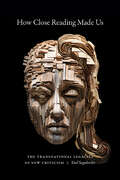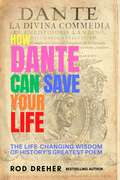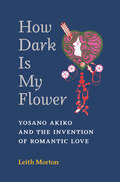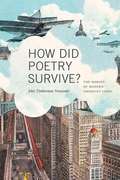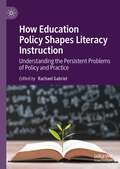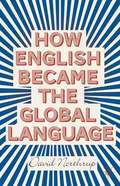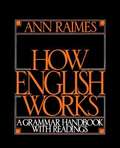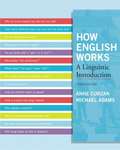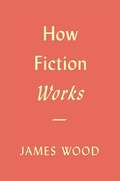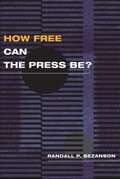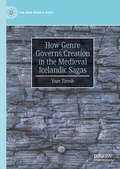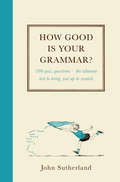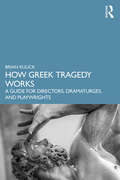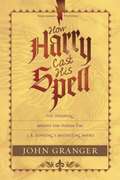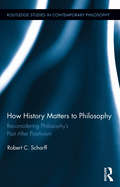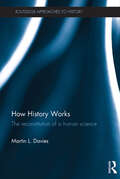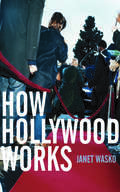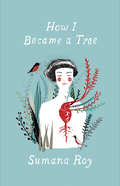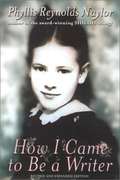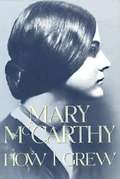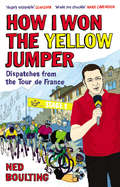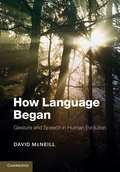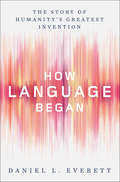- Table View
- List View
How Close Reading Made Us: The Transnational Legacies of New Criticism
by Yael SegalovitzDoes reading shape who we are? What happens to the relationship between reading and subject-formation as methods of interpretation travel globally? Yael Segalovitz probes these questions by tracing the transnational journey of the New Critical practice of close reading from the United States to Brazil and Israel in the mid-twentieth century. Challenging the traditional view of New Criticism as a purely aesthetic project, Segalovitz illustrates its underlying pedagogical objective: to cultivate close readers capable of momentarily suspending subjectivity through focused attention. How Close Reading Made Us shows that close reading, as a technique of the self, exerted a far-reaching influence on international modernist literary production, impacting writers such as Clarice Lispector, Yehuda Amichai, William Faulkner, João Guimarães Rosa, and A. B. Yehoshua. To appreciate close reading's enduring vitality in literary studies and effectively adapt this method to the present, Segalovitz argues, we must comprehend its many legacies beyond the confines of the Anglophone tradition.
How Dante Can Save Your Life: The Life-Changing Wisdom of History's Greatest Poem
by Rod DreherThe opening lines of The Divine Comedy by Dante Alighieri launched Rod Dreher on a journey that rescued him from exile and saved his life. Dreher found that the medieval poem offered him a surprisingly practical way of solving modern problems.Following the death of his little sister and the publication of his New York Times bestselling memoir The Little Way of Ruthie Leming, Dreher found himself living in the small community of Starhill, Louisiana where he grew up. But instead of the fellowship he hoped to find, he discovered that fault lines within his family had deepened. Dreher spiraled into depression and a stress-related autoimmune disease. Doctors told Dreher that if he didn&’t find inner peace, he would destroy his health. Soon after, he came across The Divine Comedy in a bookstore and was enchanted by its first lines, which seemed to describe his own condition. In the months that followed, Dante helped Dreher understand the mistakes and mistaken beliefs that had torn him down and showed him that he had the power to change his life. Dreher knows firsthand the solace and strength that can be found in Dante&’s great work, and distills its wisdom for those who are lost in the dark wood of depression, struggling with failure (or success), wrestling with a crisis of faith, alienated from their families or communities, or otherwise enduring the sense of exile that is the human condition. Inspiring, revelatory, and packed with penetrating spiritual, moral, and psychological insights, How Dante Can Save Your Life is a book for people, both religious and secular, who find themselves searching for meaning and healing. Dante told his patron that he wrote his poem to bring readers from misery to happiness. It worked for Rod Dreher. Dante saved Rod Dreher&’s life—and in this book, Dreher shows you how Dante can save yours.
How Dark Is My Flower: Yosano Akiko and the Invention of Romantic Love (Michigan Monograph Series in Japanese Studies #98)
by Leith MortonThe poetry of Yosano Akiko covers all the many and varied aspects of the experience of love—from early romantic encounters between the lover and beloved to the intimate pleasures of mutual infatuation and then true love. The journey outlined in Akiko’s verse also grapples with jealousy and unrequited passion, as Akiko’s poem-narrative treats the rivalry between herself and her best friend, the poet Yamakawa Tomiko, for the affection of the dashing young literary lion, Yosano Tekkan, who later became Akiko’s husband. Thus, How Dark Is My Flower: Yosano Akiko and the Invention of Romantic Love tells a number of stories: a real-life romance unfolds in the poetry of these three poets examined in the book, as well as the story of the journey from romanticism to modernism undertaken by early 20th century Japanese poetry. How Dark Is My Flower emphasizes the astonishing innovations in diction and style, not to mention content, in Akiko’s work that transformed the tanka genre from a hidebound and conservative mode of verse to something much more daring and modern. This book pays particular attention to poetry, particularly the tanka genre, in the evolution of modernism in Japanese literature and breaks new ground in the study of modern Japanese literature by examining the invention and evolution of the concept of romantic love.
How Did Poetry Survive?: The Making of Modern American Verse
by John Timberman NewcombThis book traces the emergence of modern American poetry at the turn of the nineteenth century. With a particular focus on four "little magazines"--Poetry, The Masses, Others, and The Seven Arts--John Timberman Newcomb shows how each advanced ambitious agendas combining urban subjects, stylistic experimentation, and progressive social ideals. While subsequent literary history has favored the poets whose work made them distinct--individuals singled out usually on the basis of a novel technique--Newcomb provides a denser, richer view of the history that hundreds of poets made.
How Education Policy Shapes Literacy Instruction: Understanding the Persistent Problems of Policy and Practice
by Rachael GabrielReading instruction is the most legislated area of education and the most frequently referenced metric for measuring educational progress. This book traces the trajectories of policy issues with direct implications for literacy teaching, learning, and research in order to illustrate the dynamic relationships between policy, research, and practice as they relate to perennial issues such as: retention in grade, remediation, intervention, instruction for English learners, early literacy instruction, coaching, and leadership. Using policy documents and peer-reviewed articles published from the 1960s to the present, the editor and authors illustrate how issues were framed, what was at stake, and how policy solutions to persistent questions have been understood over time. In doing so, the book link a generation of scholars with research that illustrates trajectories of development for ideas, strategies, and solutions.
How English Became The Global Language
by David NorthrupIn this book, the first written about the globalization of the English language by a professional historian, the exploration of English's global ascendancy receives its proper historical due. This brief, accessible volume breaks new ground in its organization, emphasis on causation, and conclusions.
How English Works: A Grammar Handbook with Readings
by Ann RaimesThis book uses readings from newspapers, works of non-fiction, and college textbooks to illustrate the use of target structures. The Student's Book provides clear presentations of the basic principles of 27 important areas of English grammar, through a wide variety of exercises and tasks for writing and editing. It engages students with topics that range from artificial intelligence and laptop computers to the environment and economics. This important grammar text provides a real-world context that allows students to see how the English language really "works. "
How English Works: A Linguistic Introduction
by Michael Adams Anne Curzan Martin Sandler Edwin Rozwenc Edward. MartinThis accessible introduction to the structure of English, general theories in linguistics, and important issues in sociolinguistics, is the first introductory linguistics textbook written specifically for English instructors and educators. Focuses on issues such as American dialects, descriptive and prescriptive approaches to English grammar, the history of English, English spelling, stylistics, language attitudes, and language education. Tapping into our natural curiosity about language, it invites readers to connect academic linguistics to everyday use of the English language and to become active participants in the construction of linguistic knowledge. The third edition provides updated examples of current language change--including new slang and other word coinages, grammatical developments, and sound changes--as well as new research findings on American dialects, language acquisition, language evolution, eggcorns, English and the Internet, and much more. For anyone interested in the structure of English, general theories in linguistics, and important issues in sociolinguistics.
How Fiction Works
by James WoodWood, a literary critic, uses many examples to show how a writer's choices determine whether his novel and the characters in it come to life, or fail to be realized.
How Free Can the Press Be?
by Randall P. BezansonIn How Free Can the Press Be? Randall P. Bezanson explores contradictions embedded in understanding press freedom in America by discussing nine of the most pivotal and provocative First Amendment cases in U.S. judicial history.
How Frogs Grow (Fountas & Pinnell LLI Green #Level G, Lesson 79)
by Stanley FrancisFountas and Pinnell Leveled Literacy Intervention Green System -- 1st Grade
How Genre Governs Creation in the Medieval Icelandic Sagas (The New Middle Ages)
by Yoav TiroshThis book sets out to answer why genre matters when analysing sagas, medieval literature, and creation in general. How Genre Governs Creation in the Medieval Icelandic Sagas applies theoretical observations on the workings of genre to saga literature analysis, including media and film genre theory, as well as observations from reader-response theory. The text primarily focuses on Íslendingasögur, a group of prose or prosimetric texts that concern the medieval Norse world, usually taking place in the period between the end of the ninth and the mid-eleventh centuries and focusing on Iceland. Tirosh proposes new interpretations to several sagas, but more importantly provides a fresh perspective on the importance and application of genre theory to medieval literary studies.
How Good Is Your Grammar?: (Probably Better Than You Think)
by John SutherlandJohn Sutherland, one of Britain's most celebrated professors of English literature, is here to test, stretch, amuse and instruct you with his definitive quiz on all things grammatical.Why do purists insist that 'television' is wrong while telephone is correct?Was Bill Clinton taking risks with language as well as his presidency when he declared, 'I did not have sexual relations with that woman'?And can the use of 'ain't' ever be defended, especially when there's no sunshine when she's gone?This is neither a rule book nor a primer but a rollercoaster ride through the mysteries and magic of the world's greatest language.
How Good Is Your Grammar?: (Probably Better Than You Think)
by John SutherlandJohn Sutherland, one of Britain's most celebrated professors of English literature, is here to test, stretch, amuse and instruct you with his definitive quiz on all things grammatical.Why do purists insist that 'television' is wrong while telephone is correct?Was Bill Clinton taking risks with language as well as his presidency when he declared, 'I did not have sexual relations with that woman'?And can the use of 'ain't' ever be defended, especially when there's no sunshine when she's gone?This is neither a rule book nor a primer but a rollercoaster ride through the mysteries and magic of the world's greatest language.
How Greek Tragedy Works: A Guide for Directors, Dramaturges, and Playwrights
by Brian KulickHow Greek Tragedy Works is a journey through the hidden meanings and dual nature of Greek tragedy, drawing on its foremost dramatists to bring about a deeper understanding of how and why to engage with these enduring plays. Brian Kulick dispels the trepidation that many readers feel with regard to classical texts by equipping them with ways in which they can unpack the hidden meanings of these plays. He focuses on three of the key texts of Greek theatre: Aeschylus' Agamemnon, Euripides' The Bacchae, and Sophocles' Electra, and uses them to tease out the core principles of the theatre-making and storytelling impulses. By encouraging us to read between the lines like this, he also enables us to read these and other Greek tragedies as artists' manifestos, equipping us not only to understand tragedy itself, but also to interpret what the great playwrights had to say about the nature of plays and drama. This is an indispensable guide for anyone who finds themselves confronted with tackling the Greek classics, whether as a reader, scholar, student, or director.
How Harry Cast His Spell: The Meaning Behind the Mania for J. K. Rowling's Bestselling Books
by John GrangerTracing spiritual content and symbols through the entire series, Granger uses his knowledge of classic literature, philosophy, and Christian tradition to explain why the books 1) meet our longings to experience the truths of life, love, and death; 2) help us better understand life and our role in the universe; and 3) encourage us to discover and develop our own gift and abilities. A must-read book for fans, parents, and teachers that will serve as a bridge to growth in faith and spiritual understanding.
How History Matters to Philosophy: Reconsidering Philosophy’s Past After Positivism (Routledge Studies in Contemporary Philosophy)
by Robert C. ScharffIn recent decades, widespread rejection of positivism’s notorious hostility toward the philosophical tradition has led to renewed debate about the real relationship of philosophy to its history. How History Matters to Philosophy takes a fresh look at this debate. Current discussion usually starts with the question of whether philosophy’s past should matter, but Scharff argues that the very existence of the debate itself demonstrates that it already does matter. After an introductory review of the recent literature, he develops his case in two parts. In Part One, he shows how history actually matters for even Plato’s Socrates, Descartes, and Comte, in spite of their apparent promotion of conspicuously ahistorical Platonic, Cartesian, and Positivistic ideals. In Part Two, Scharff argues that the real issue is not whether history matters; rather it is that we already have a history, a very distinctive and unavoidable inheritance, which paradoxically teaches us that history’s mattering is merely optional. Through interpretations of Dilthey, Nietzsche, and Heidegger, he describes what thinking in a historically determinate way actually involves, and he considers how to avoid the denial of this condition that our own philosophical inheritance still seems to expect of us. In a brief conclusion, Scharff explains how this book should be read as part of his own effort to acknowledge this condition rather than deny it.
How History Works: The Reconstitution of a Human Science (Routledge Approaches to History)
by Martin L. DaviesHow History Works assesses the social function of academic knowledge in the humanities, exemplified by history, and offers a critique of the validity of historical knowledge. The book focusses on history’s academic, disciplinary ethos to offer a reconception of the discipline of history, arguing that it is an existential liability: if critical analysis reveals the sense that history offers to the world to be illusory, what stops historical scholarship from becoming a disguise for pessimism or nihilism? History is routinely invoked in all kinds of cultural, political, economic, psychological situations to provide a reliable account or justification of what is happening. Moreover, it addresses a world already receptive to comprehensive historical explanations: since everyone has some knowledge of history, everyone can be manipulated by it. This book analyses the relationship between specialized knowledge and everyday experience, taking phenomenology (Husserl) and pragmatism (James) as methodological guides. It is informed by a wide literature sceptical of the sense academic historical expertise produces and of the work history does, represented by thinkers such as Schopenhauer, Nietzsche, Valéry, Anders and Cioran. How History Works discusses how history makes sense of the world even if what happens is senseless, arguing that behind the smoke-screen of historical scholarship looms a chaotic world-dynamic indifferent to human existence. It is valuable reading for anyone interested in historiography and historical theory.
How Hollywood Works
by Janet WaskoThis is a book about the US motion picture industry - its structure and policies, its operations and practices. It looks at the processes that are involved in turning raw materials and labor into feature films. It describes the process of film production, distribution, exhibition and retail - a process that involves different markets where materials, labor and products are bought and sold. In other words, this is a book about how Hollywood works - as an industry. How Hollywood Works: - offers an up-to-date survey of the policies and structure of the US film industry - looks at the relationship between the film industry and other media industries - examines the role of the major studios and the other 'players' - including, law firms, talent agents, and trade unions and guilds - provides access to hard-to-find statistical information on the industry While many books describe the film production and marketing process, they usually do so from an industry perspective and few look at Hollywood critically from within a more general economic, political and social context. By offering just such a critique, Janet Wasko's text provides a timely and essential analysis of how Hollywood works for all students of film and media.
How I Became a Tree
by Sumana RoyAn exquisite, lovingly crafted meditation on plants, trees, and our place in the natural world, in the tradition of Robin Wall Kimmerer’s Braiding Sweetgrass and Annie Dillard’s Pilgrim at Tinker Creek. <p><p> I was tired of speed. I wanted to live tree time.” So writes Sumana Roy at the start of How I Became a Tree, her captivating, adventurous, and self-reflective vision of what it means to be human in the natural world. <p><p> Drawn to trees’ wisdom, their nonviolent way of being, their ability to cope with loneliness and pain, Roy movingly explores the lessons that writers, painters, photographers, scientists, and spiritual figures have gleaned through their engagement with trees—from Rabindranath Tagore to Tomas Tranströmer, Ovid to Octavio Paz, William Shakespeare to Margaret Atwood. Her stunning meditations on forests, plant life, time, self, and the exhaustion of being human evoke the spacious, relaxed rhythms of the trees themselves. <p><p> Hailed upon its original publication in India as “a love song to plants and trees” and “an ode to all that is unnoticed, ill, neglected, and yet resilient,” How I Became a Tree blends literary history, theology, philosophy, botany, and more, and ultimately prompts readers to slow down and to imagine a reenchanted world in which humans live more like trees.
How I Came to Be a Writer
by Phyllis Reynolds NaylorDetails the career of one writer from her published pieces to novels written to date.
How I Grew
by Mary MccarthyThis remarkable personal memoir focuses on eight crucial years of McCarthy's life-from ages 13 to 21, from high school in the Seattle area through college at Vassar.
How I Won the Yellow Jumper: Dispatches from the Tour de France
by Ned Boulting'Paris, 4 July 2003: My first Tour de France. I had never seen a bike race. I had only vaguely heard of Lance Armstrong. I had no idea what I was doing there. Yet, that day I was broadcasting live on television. I fumbled my way through a few platitudes, before summing up with the words, "...Dave Millar just missing out on the Yellow Jumper." Yes, the Yellow Jumper.'Follow Ned Boulting's (occasionally excruciating) experiences covering the world's most famous cycling race. His story offers an insider's view of what really goes on behind the scenes of the Tour. From up-close-and-personal encounters with Lance Armstrong to bewildered mishaps with the local cuisine, Ned's been there, done that and got the crumpled-looking t-shirt. Eight Tours on from Ned's humbling debut, he has grown to respect, mock, adore and crave the race in equal measure. What's more, he has even started to understand it. Includes How Cav Won the Green Jersey: Short Dispatches from the 2011 Tour de France
How Language Began
by David McneillHuman language is not the same as human speech. We use gestures and signs to communicate alongside, or instead of, speaking. Yet gestures and speech are processed in the same areas of the human brain, and the study of how both have evolved is central to research on the origins of human communication. Written by one of the pioneers of the field, this is the first book to explain how speech and gesture evolved together into a system that all humans possess. Nearly all theorizing about the origins of language either ignores gesture, views it as an add-on or supposes that language began in gesture and was later replaced by speech. David McNeill challenges the popular 'gesture-first' theory that language first emerged in a gesture-only form and proposes a groundbreaking theory of the evolution of language which explains how speech and gesture became unified.
How Language Began: The Story Of Humanity's Greatest Invention
by Daniel L. EverettHow Language Began revolutionizes our understanding of the one tool that has allowed us to become the "lords of the planet." Mankind has a distinct advantage over other terrestrial species: we talk to one another. But how did we acquire the most advanced form of communication on Earth? Daniel L. Everett, a “bombshell” linguist and “instant folk hero” (Tom Wolfe, Harper’s), provides in this sweeping history a comprehensive examination of the evolutionary story of language, from the earliest speaking attempts by hominids to the more than seven thousand languages that exist today. Although fossil hunters and linguists have brought us closer to unearthing the true origins of language, Daniel Everett’s discoveries have upended the contemporary linguistic world, reverberating far beyond academic circles. While conducting field research in the Amazonian rainforest, Everett came across an age-old language nestled amongst a tribe of hunter-gatherers. Challenging long-standing principles in the field, Everett now builds on the theory that language was not intrinsic to our species. In order to truly understand its origins, a more interdisciplinary approach is needed—one that accounts as much for our propensity for culture as it does our biological makeup. Language began, Everett theorizes, with Homo Erectus, who catalyzed words through culturally invented symbols. Early humans, as their brains grew larger, incorporated gestures and voice intonations to communicate, all of which built on each other for 60,000 generations. Tracing crucial shifts and developments across the ages, Everett breaks down every component of speech, from harnessing control of more than a hundred respiratory muscles in the larynx and diaphragm, to mastering the use of the tongue. Moving on from biology to execution, Everett explores why elements such as grammar and storytelling are not nearly as critical to language as one might suspect. In the book’s final section, Cultural Evolution of Language, Everett takes the ever-debated “language gap” to task, delving into the chasm that separates “us” from “the animals.” He approaches the subject from various disciplines, including anthropology, neuroscience, and archaeology, to reveal that it was social complexity, as well as cultural, physiological, and neurological superiority, that allowed humans—with our clawless hands, breakable bones, and soft skin—to become the apex predator. How Language Began ultimately explains what we know, what we’d like to know, and what we likely never will know about how humans went from mere communication to language. Based on nearly forty years of fieldwork, Everett debunks long-held theories by some of history’s greatest thinkers, from Plato to Chomsky. The result is an invaluable study of what makes us human.
